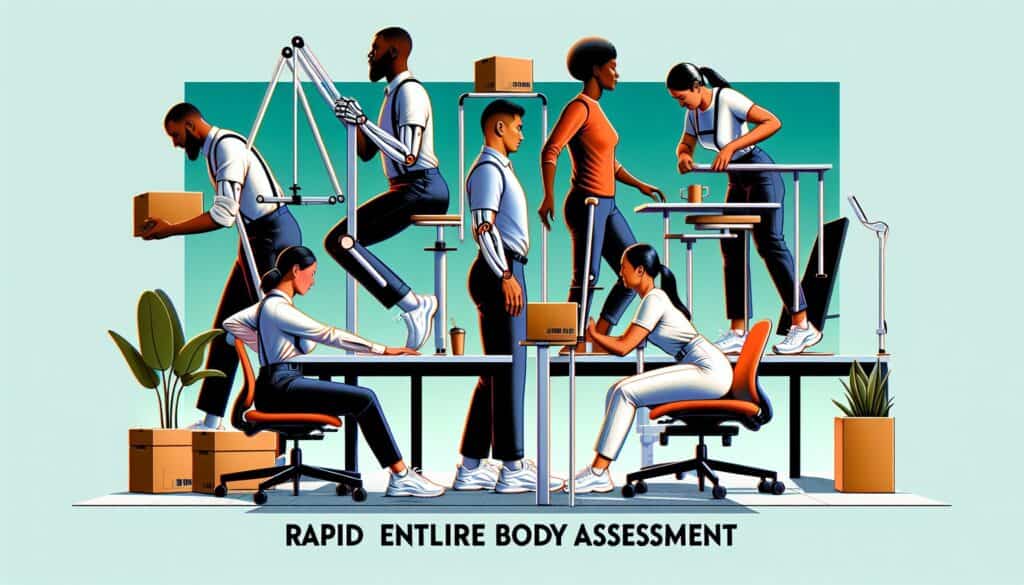An observational tool used to assess postural risks for work-related entire body musculoskeletal disorders.
- Methodologies: Engineering, Ergonomics
REBA (Rapid Entire Body Assessment)

REBA (Rapid Entire Body Assessment)
- Continuous Improvement, Ergonomics, Human Factors, Human-Centered Design, Lean Manufacturing, Process Improvement, Quality Management, Risk Management, Safety
Objective:
How it’s used:
- Evaluates postures of the neck, trunk, legs, and arms, as well as coupling, load/force, and activity. Scores are generated to indicate the level of MSD risk and the urgency for intervention.
Pros
- Provides a holistic assessment of entire body postural risks; relatively quick to use; helps prioritize jobs for ergonomic improvements.
Cons
- Can be subjective; requires training for consistent scoring; primarily a screening tool, may need further analysis for detailed intervention design.
Categories:
- Ergonomics
Best for:
- Assessing postural risks for musculoskeletal disorders affecting the whole body.
REBA (Rapid Entire Body Assessment) methodology finds application across various industries including manufacturing, construction, healthcare, and logistics, where employees are frequently engaged in tasks requiring repetitive motion or sustained awkward postures. This assessment is particularly valuable during the design phase of workspaces or workflows, especially when considering the physical demands on workers, allowing teams to evaluate and redesign task specifics that might lead to injury. In engineering and product design contexts, participants often include ergonomists, health and safety professionals, and team leaders who are responsible for optimizing workflows. The methodology facilitates objective evaluation by generating numerical scores that categorize the level of musculoskeletal disorder (MSD) risk associated with specific postures and tasks, thereby prioritizing jobs for ergonomic interventions. The quick application of REBA encourages its use in routine assessments, enabling companies to regularly monitor changes in posture and work conditions, ultimately aiming to reduce injury rates and improve worker well-being. Training sessions could be organized to educate employees at all levels on REBA, cultivating an awareness of ergonomic principles that promote a safer working environment. Regular application of these assessments not only aids in compliance with occupational health guidelines but also enhances productivity by reducing fatigue and absenteeism associated with MSDs.
Key steps of this methodology
- Observe the posture of the worker during the task.
- Rate the posture of the neck, trunk, legs, and arms using predefined scoring criteria.
- Evaluate the level of coupling between body parts during the task.
- Assess any load or force exerted on the body.
- Consider the specific activity being performed and its demands.
- Calculate the total score based on the individual ratings.
- Determine the level of risk for musculoskeletal disorders based on the score.
- Prioritize the need for intervention based on the assessment results.
Pro Tips
- Incorporate a dynamic assessment approach by combining REBA findings with a time-motion study to enhance understanding of repetitive tasks and their impact on worker posture.
- Utilize digital tools, such as motion capture software, to supplement REBA analysis for a more precise identification of postural risks and force applications.
- Regularly update the REBA scoring criteria based on emerging research and best practices to ensure relevance and accuracy in assessing modern workplace environments.
To read and compare several methodologies, we recommend the
> Extensive Methodologies Repository <
together with the 400+ other methodologies.
Your comments on this methodology or additional info are welcome on the comment section below ↓ , so as any engineering-related ideas or links.
Historical Context
1986
(if date is unknown or not relevant, e.g. "fluid mechanics", a rounded estimation of its notable emergence is provided)

Related Posts
Musculoskeletal Discomfort Questionnaires
Multivariate Testing (MVT)
Multiple Regression Analysis
Motion Capture Systems
MoSCoW Method
Mood’s Median Test